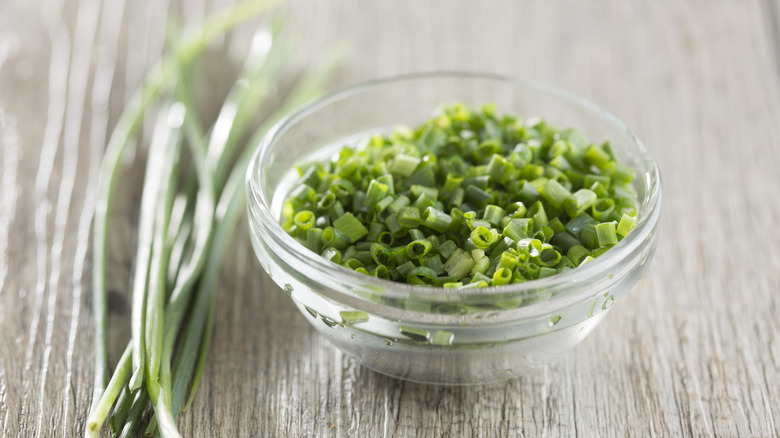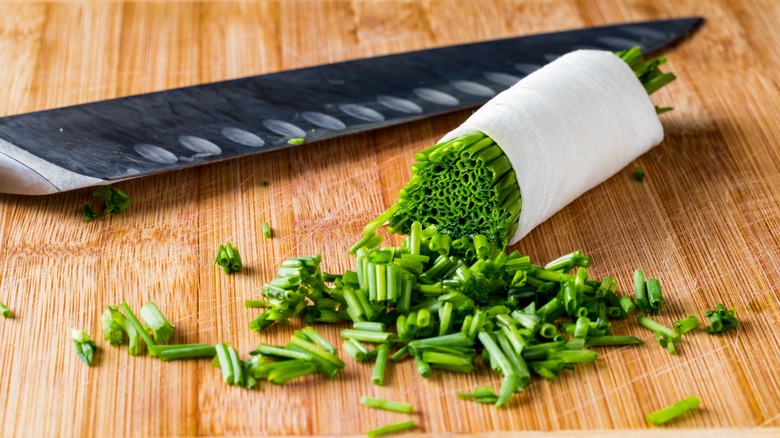For Beautifully Chopped Chives, Try The Back-Slicing Technique
When you find your go-to kitchen routine, it can be hard to mix things up. But, an easy and fast way to infuse new flavors into your favorite recipes is through fresh herbs. Chives, in particular, are an under-celebrated allium that can deliver the savory whiff of onions without the bite.
They're versatile and elegant, and chefs use them as a secret weapon to gussy up everything from elegant poached fish to reheated chicken. However, like most tender greens, they require a delicate touch to ensure they make it from your cutting board to your plate with ease. To utilize the seasoning at home, you may wan to try a technique called back-slicing to precisely prep the green shoots.
Do so by gently gripping a pile of the herbs, and, starting at the base of the chives, gliding the blade back and forth along the surface of the cutting board. The backward momentum will help shave off thin rings from the stems, but try not to lift the tip of your knife off your board after each pass. The horizontal motion, rather than the up and down of chopping, will take getting used to, but you'll soon find yourself with a pile of bruise-free garnishes ready for use.
Benefits of back-slicing veggies like green onions
The reason professionals opt for the precision of back-slicing is because it's efficient. Though you might be tempted to simply re-cut chives and other fine herbs that aren't hair-thin in a traditional manner, you'll just end up pushing all those wonderful aromatic oils into the cutting board. The more they're handled, the more the delicate greens wilt, bruise, and release their flavor early.
In addition to practicing the saw-like movement, there are a few other tricks you can employ to nail your knife work on delicate veggies like chives on the first try. Start by getting out a whetstone — or taking your knives to the grocery store — to sharpen your blades. The repetitive rocking of back-slicing relies on your blade's edge to cut through the plants. And dull equipment will leave you with jagged, torn herbs and ultimately require more work from you to penetrate through the skin.
If you're having trouble keeping hold of the pile of stems, one insider trick is to wrap the greens with a damp paper towel. The material holds the bundle tight and also gives your safely-tucked fingers a place to rest as you cut. Just make sure to pause and shift the makeshift grip lower as you move through the garnish.
Extra tips for handling herbs
Before you start the slicing process with chives, it's important to take some time to pat any rinsed pieces dry. Skipping this step will leave your fingers and knife coated in the green shavings, making it hard to cut precisely. Or worse, the fibrous stems will start to disintegrate from the moisture as you chop, forcing you to rush through it.
The same drying advice goes for other fresh herbs, like scallions, which can also benefit from the back-slice technique. Chefs often employ the back-and-forth movement to chiffonade basil, mint, sage, and other leaves, too. The difference is that, before the knives come out, they roll the leaves into a tube, similar to a cigarette, before shaving off thin ribbons of the ingredients, which you can try too.
After you've finished prepping, resist the urge to use your knife to scrape the herbs into your bowl, as this can actually dull your newly sharpened edge. Instead, flip your knife over and use the top of your blade to maneuver your chives. Or, better yet, pull out your handy bench scraper, a flat-edged tool typically used in baking to unstick dough from surfaces, to gently push the garnish. You'll avoid squishing the delicate plants and get all the fragrance safely to the next destination.



